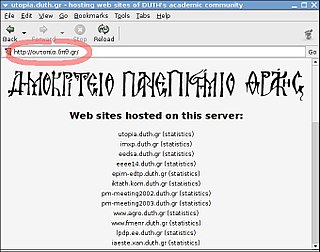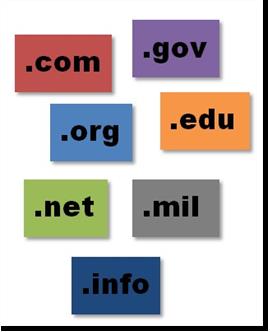
The Internet Corporation for Assigned Names and Numbers is an American multistakeholder group and nonprofit organization responsible for coordinating the maintenance and procedures of several databases related to the namespaces and numerical spaces of the Internet, ensuring the network's stable and secure operation. ICANN performs the actual technical maintenance work of the Central Internet Address pools and DNS root zone registries pursuant to the Internet Assigned Numbers Authority (IANA) function contract. The contract regarding the IANA stewardship functions between ICANN and the National Telecommunications and Information Administration (NTIA) of the United States Department of Commerce ended on October 1, 2016, formally transitioning the functions to the global multistakeholder community.
A top-level domain (TLD) is one of the domains at the highest level in the hierarchical Domain Name System of the Internet after the root domain. The top-level domain names are installed in the root zone of the name space. For all domains in lower levels, it is the last part of the domain name, that is, the last non empty label of a fully qualified domain name. For example, in the domain name www.example.com, the top-level domain is .com. Responsibility for management of most top-level domains is delegated to specific organizations by the ICANN, an Internet multi-stakeholder community, which operates the Internet Assigned Numbers Authority (IANA), and is in charge of maintaining the DNS root zone.
A domain name is a string that identifies a realm of administrative autonomy, authority or control within the Internet. Domain names are often used to identify services provided through the Internet, such as websites, email services and more. As of 2017, 330.6 million domain names had been registered. Domain names are used in various networking contexts and for application-specific naming and addressing purposes. In general, a domain name identifies a network domain or an Internet Protocol (IP) resource, such as a personal computer used to access the Internet, or a server computer.
A domain name registry is a database of all domain names and the associated registrant information in the top level domains of the Domain Name System (DNS) of the Internet that enables third party entities to request administrative control of a domain name. Most registries operate on the top-level and second-level of the DNS.

An internationalized domain name (IDN) is an Internet domain name that contains at least one label displayed in software applications, in whole or in part, in non-latin script or alphabet, such as Arabic, Bengali, Chinese, Cyrillic, Devanagari, Greek, Hebrew, Hindi, Tamil or Thai or in the Latin alphabet-based characters with diacritics or ligatures, such as French, German, Italian, Polish, Portuguese or Spanish. These writing systems are encoded by computers in multibyte Unicode. Internationalized domain names are stored in the Domain Name System (DNS) as ASCII strings using Punycode transcription.
A country code top-level domain (ccTLD) is an Internet top-level domain generally used or reserved for a country, sovereign state, or dependent territory identified with a country code. All ASCII ccTLD identifiers are two letters long, and all two-letter top-level domains are ccTLDs.

.ae is the country code top-level domain (ccTLD) in the Domain Name System of the Internet for the United Arab Emirates. It is administered by .aeDA which is part of the Telecommunications and Digital Government Regulatory Authority of UAE (TDRA).

Generic top-level domains (gTLDs) are one of the categories of top-level domains (TLDs) maintained by the Internet Assigned Numbers Authority (IANA) for use in the Domain Name System of the Internet. A top-level domain is the last level of every fully qualified domain name. They are called generic for historical reasons; initially, they were contrasted with country-specific TLDs in RFC 920.
A sponsored top-level domain (sTLD) is one of the categories of top-level domains (TLDs) maintained by the Internet Assigned Numbers Authority (IANA) for use in the Domain Name System of the Internet, alongside country-code top-level domains (ccTLD) and generic top-level domains (gTLD).

.so is the internet country code top-level domain (ccTLD) for Somalia. After a long absence, the .so domain was officially relaunched on November 1, 2010, by .SO Registry, which is regulated by the nation's Ministry of Posts and Telecommunications. It was launched through various accredited registrars around the world.

.africa is the officially designated top-level domain (TLD) for the African and Pan African communities and users wherever they reside. It is a sponsored generic top-level domain (gTLD) operated by the Registry Africa. The .africa namespace is open to individuals, businesses and organizations around the world. The .africa domains are intended to showcase their brand and commitment to the African continent, establishing a home for Africa-specific products and services, expanding a brand's regional influence and acquiring online real-estate.

The .quebec domain is a new GeoTLD and Community Priority Application that was proposed to ICANN's New gTLD Program by PointQuébec, a non-profit organisation. The organisation aims to improve the businesses, culture, tourism, and online identity of Quebec and the Canadians through the .quebec TLD. According to the PointQuébec organisation, .quebec will allow all Quebecers to register their domain names under .quebec.
.music is a community-based top-level domain name (TLD) operated for the benefit of the global music community. It was one of the most highly contested new gTLDs, with eight applicants in contention.
.wiki is a top-level domain name. It was proposed in ICANN's New generic top-level domain (gTLD) Program, and became available to the general public on May 26, 2014. Top Level Design is the domain name registry for the string.

.kaufen is a proposed top-level domain (TLD) in ICANN's New gTLD Program. The applicant is Demand Media. The proposed application succeeded and was delegated to the Root Zone on 29 December 2013.
.college is a generic-top-level domain (gTLD) used in the domain name system of the Internet. It was delegated to the Root Zone of the DNS on 10 April 2014, completing the successful application for the string. The .college back-end registry operations are provided by CentralNic. Unlike .edu, .college is open for registration to the general public.
.vlaanderen is a generic top-level domain for Flanders, Belgium first introduced in 2014.

.wtf is a generic top-level domain (gTLD) run by Donuts, a gTLD registry. It is derived from "WTF", an online acronym for "what the fuck?".

.cloud is a generic top-level domain (gTLD) delegated by ICANN. It is managed by the Italian company Aruba PEC SpA, a wholly owned subsidiary of the same Aruba S.p.A., one of the largest distributors of Hostings and Providers in Europe.










